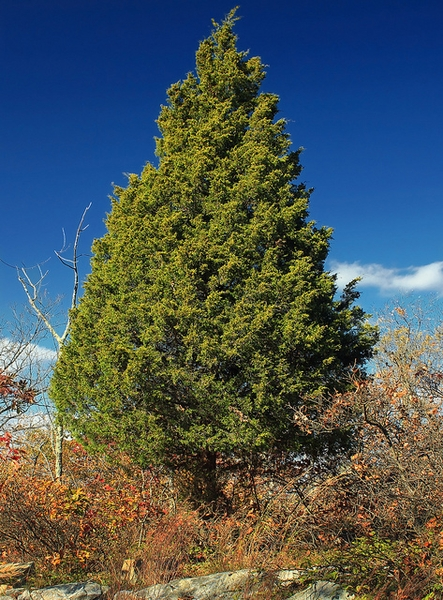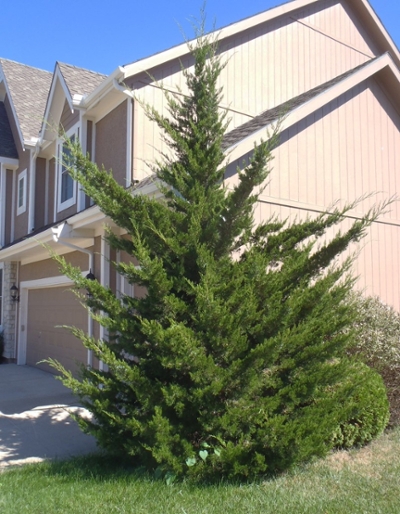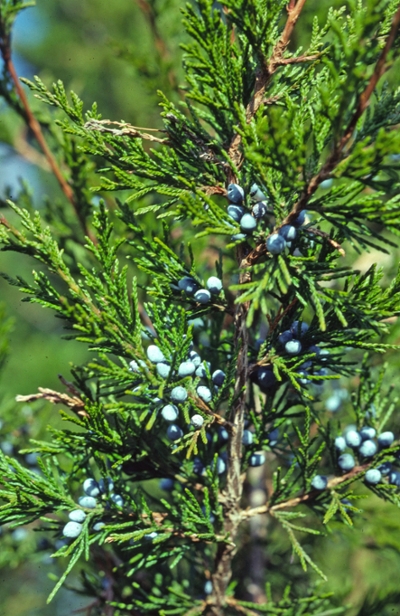Juniperus virginiana: 'Eastern Red Cedar'
Latin name: Juniperus virginiana
Common name: Eastern Red Cedar
Flowers: Yellow, not showy, spring/winter13
Fruit: Small, blue, fall/winter13
Height & Width: 40-50 ft. tall, 10-20 ft. wide15
Type: Evergreen12
Habit: Oval, columnar, pyramidal15
Wetland indicator category**: FACU17
Texture: Fine15
Growth rate: Fast15
Light: Sun, part-shade, shade10
Moisture: Dry10
Soil: Acidic, slightly acidic, slightly alkaline, alkaline6
Zones: 2A-9B15
Origin: Canada, Lower 4816
Ecosystem Services: Birds eat fruit15
Features: Dense growth and heavy, green, attractive foliage, fragrant bark repels insects13,15.
Siting: Windbreak, screen, or wildlife cover when planted in a row, street tree when planted spaced out13,15.
Care: Plant so root flare is visible at soil surface14. At planting, water the root ball daily with two gallons of water per inch of trunk diameter for two weeks, every other day for two months and then weekly until established. Modify water recommendations to reflect site drainage and rainfall. Apply 3” of mulch over the planted area. Do not allow mulch to touch the trunk14. Water until well-established. Tree is low-maintenance after established15.
Pests: None are serious. Possible bagworm caterpillars, juniper scale, juniper webworm, mites15.
This plant does not appear on the following invasive plant lists on (2/12/21): enter date searched and check the lists that were examined
USDA SC Invasive Plant Species Web site at http://www.invasivespeciesinfo.gov/plants/main.shtml
SC Exotic Plant Pest Council Web site at http://www.se-eppc.org/southcarolina/
Sources:
(1) Armitage, A. (2001). Armitage’s manual of annuals, biennials, and half-hardy perennials. Portland, OR: Timber Press.
(2) Armitage, A. (2006). Armitage’s native plants for North American gardens. Portland, Oregon: Timber Press.
(3) Armitage, A. (2008). Herbaceous perennial plants: A treatise on their identification, culture, and garden attributes. Athens, GA: University of Georgia.
(4) Clemson Cooperative Extension Home and Garden Information Center.(2011). Flowers fact sheets. Retrieved from http://www.clemson.edu/extension/hgic/plants/landscape/flowers/
(5) Clemson Cooperative Extension Home and Garden Information Center.(2011). Groundcovers & vines fact sheets. Retrieved from http://www.clemson.edu/extension/hgic/plants/landscape/groundcovers/
(6) Clemson Cooperative Extension Home and Garden Information Center. (2011). Trees. Retrieved from http://www.clemson.edu/extension/hgic/plants/landscape/trees
(7) Clemson Cooperative Extension Home and Garden Information Center.(2011). Shrubs. Retrieved from http://www.clemson.edu/extension/hgic/plants/landscape/shrubs/
(8) Dirr, M. A. (2009). Manual of woody landscape plants. Champaign, IL: Stipes Publishing.
(9) Gilman, E. F. (1997). Trees for urban and suburban landscapes. Albany, NY: Delmar Publishers.
(10) Lady Bird Johnson Wildflower Center University of Texas at Austin. (2012). Native plant information network. Retrieved from http://www.wildflower.org/explore/
(11) McMillan, P., Plant taxonomist Clemson University, personal communication.
(12) Missouri Botanical Garden Kemper Center for Home Gardening. Plant finder. Retrieved from http://www.mobot.org/gardeninghelp/plantfinder/Alpha.asp
(13) North Carolina State University (2005). Plant fact sheets. Retrieved from http://www.ces.ncsu.edu/depts/hort/consumer/factsheets/index.html
(14) Strother, E. V., Ham, D. L., Gilland, L. (2003) Urban tree species guide: Choosing the right tree for the right place. Columbia, SC: South Carolina Forestry Commission.
(15) University of Florida, IFAS Extension. (2011). Southern trees fact sheet. Retrieved from http://edis.ifas.ufl.edu/department_envhort-trees
(16) USDA. Plant profile. (n/d).Retrieved from http://plants.usda.gov/java/
(17) USDA. Plant wetland indicator status. (n/d). Retrieved from http://plants.usda.gov/wetland.html
(18) Vincent, E., Environmental horticulturist Clemson University, personal communication.
Soil pH is determined using a professional soil test. Contact your Clemson University County Extension service for assistance www.clemson.edu/extension/. Click on “local offices”.
**2012 Plant Wetland Indicator categories (quantitative derived) http://plants.usda.gov/wetinfo.html
|
Indicator Code |
Indicator Status |
Comment |
|
OBL |
Obligate Wetland |
Almost always is a hydrophyte, rarely in uplands |
|
FACW |
Facultative Wetland |
Usually is a hydrophyte but occasionally found in uplands |
|
FAC |
Facultative |
Commonly occurs as either a hydrophyte or non-hydrophyte |
|
FACU |
Facultative Upland |
Occasionally is a hydrophyte but usually occurs in uplands |
|
UPL |
Obligate Upland |
Rarely is a hydrophyte, almost always in uplands |



